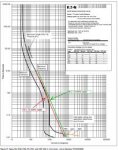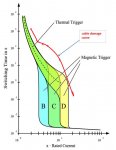MG44312
New member
- Location
- Columbia, SC, US
I am trying to determine if a current installation meets the NEC.
I'm looking at a breaker Time Current Curve (TCC) and comparing it with the installed cable (10 AWG 90 C). The panel connections are rated at 75 C. The breaker is a 30A 3P 480V breaker.
My understanding is that cable damage curves are determined using the following equation:
t=0.0297*log[(T2+234)/(T1+234)](A/I)^2
Where:
t = time of short circuit from .01 to 10 seconds
A = Conductor area (10380 for #10)
I = short circuit current
T1 = cable temperature rating (90 C)
T2 = max short circuit temp (250 C)
Regarding ampacity, NEC table 310.15(B)(16) (formerly 310.16) gives 35A ampacity for 75 C 10 AWG. Since the breaker is 30A and cable ampacity is 35A this should be acceptable.
The issue I have is regarding conductor temperature. If I plot the cable damage line for 90 C 10 AWG it envelopes the breaker curve. But if I am to de-rate the cable to 75 C with a max short circuit temp of 150 C, the curve no longer envelopes the breaker TCC. This suggests to me that the panel connections would potentially overheat in the given scenario. Note that the 250 C and 150 C max short circuit temps are common values I've found for 90 C and 75 C cable respectively. I don't know that the NEC specifies these values anywhere.
So my questions are:
1. Should I plot the curve for 90 C cable or 75 C cable?
2. Should I even be plotting damage curves at all or does table 310.15(B)(16) already take this into account? (I read in another post that cable damage curves shouldn't be plotted in low voltage applications)
Cable damage curves plotted for given breaker is attached:

Thanks
I'm looking at a breaker Time Current Curve (TCC) and comparing it with the installed cable (10 AWG 90 C). The panel connections are rated at 75 C. The breaker is a 30A 3P 480V breaker.
My understanding is that cable damage curves are determined using the following equation:
t=0.0297*log[(T2+234)/(T1+234)](A/I)^2
Where:
t = time of short circuit from .01 to 10 seconds
A = Conductor area (10380 for #10)
I = short circuit current
T1 = cable temperature rating (90 C)
T2 = max short circuit temp (250 C)
Regarding ampacity, NEC table 310.15(B)(16) (formerly 310.16) gives 35A ampacity for 75 C 10 AWG. Since the breaker is 30A and cable ampacity is 35A this should be acceptable.
The issue I have is regarding conductor temperature. If I plot the cable damage line for 90 C 10 AWG it envelopes the breaker curve. But if I am to de-rate the cable to 75 C with a max short circuit temp of 150 C, the curve no longer envelopes the breaker TCC. This suggests to me that the panel connections would potentially overheat in the given scenario. Note that the 250 C and 150 C max short circuit temps are common values I've found for 90 C and 75 C cable respectively. I don't know that the NEC specifies these values anywhere.
So my questions are:
1. Should I plot the curve for 90 C cable or 75 C cable?
2. Should I even be plotting damage curves at all or does table 310.15(B)(16) already take this into account? (I read in another post that cable damage curves shouldn't be plotted in low voltage applications)
Cable damage curves plotted for given breaker is attached:

Thanks


